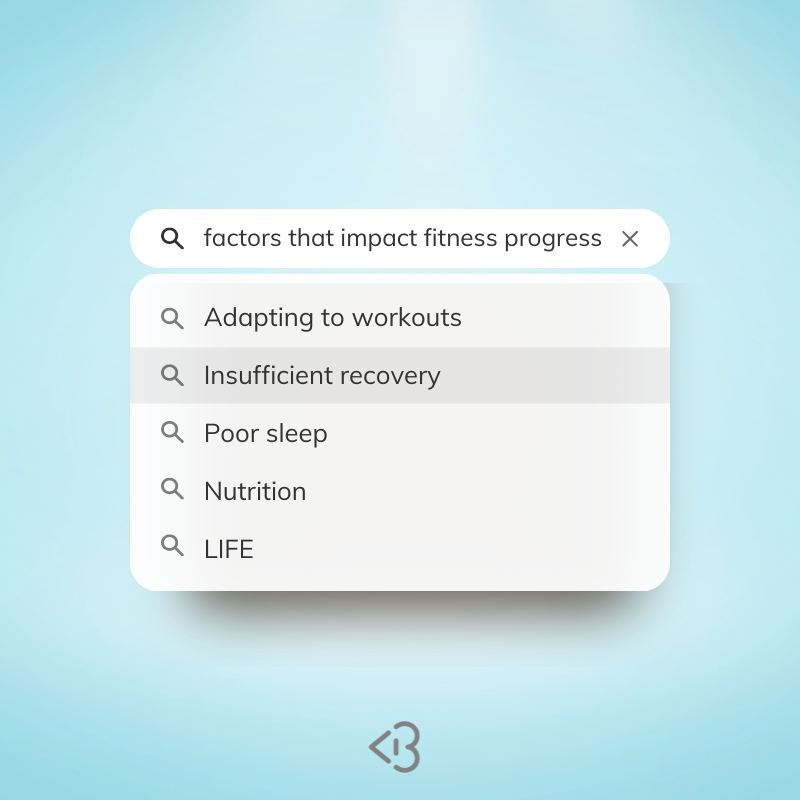
As an organization lover and a self-recognized Type A, I love things to follow a concrete path. I derive satisfaction from neatly tracking things step by step as if my life were a personal line graph heading towards my goals. Anyone else?
While this progressive tracking may make sense in some areas of your life, it doesn’t apply to fitness. Instead of the tidy line graph I know and love, health and fitness progress is likely to look like some squiggly waves and loops trending in an upward trajectory. Regardless of where you are in your health and fitness journey, there’s going to be some upslopes and downslopes because fitness progress is not linear.
So, what do these waves look and feel like?
As you kick off a new workout program (perhaps one of our favorite challenges!), you may notice immediate progress. You might be able to increase reps or weight day to day, you might notice a boost in both sleep quality and energy and your clothes might even start to fit differently.
This upward trend on your personal fitness line graph might start to naturally dip as you continue on though. Your progress on rep and weight increases may slow or stall, your energy level may stay the same and your clothes may fit the same week over week. It’s probable that you are also going to have some workouts that just don’t feel great. You might feel sluggish, tired, sore and unmotivated.
The path to your goals will have ups and downs
First things first: these dips are normal, natural and to be expected in your fitness journey. You are not alone in this.
Progress is often rapid at first
When we look at the beginning of training cycles, most people often see rapid progress, which results from a few things. Firstly, you are training your nervous system to efficiently recruit and use the muscles you already have. As such, you’re likely not lifting, running or cycling to your full muscular potential.
As your nervous system intelligently catches on, you’re able to eventually meet your potential, which is why you may notice that you can quickly up your intensity in the first few weeks or that your body composition shifts as your muscles begin to work in a different, more efficient manner.
Progress may slow as your body adapts
As you continue to increase your intensity and volume in your fitness schedule, muscular growth begins to accompany this nervous system training. Muscular growth happens on a slower rate and also depends on the growth of blood vessels, fascia and other organs that support the muscular system — all of which take time.
At the same time that your body is adapting to muscle growth, you’re simultaneously fatiguing your nervous system and your existing muscles and tendons, which need time to recover before functioning at their highest levels. The more intense your workout is, the longer your recovery period may be, and thus, you may see a dip in your progress.
Life happens
In addition to your body’s physiology, life happens. A classic progress-oriented line graph doesn’t account for injury or sickness recovery where you can’t push to your max, a morning after a restless night with a sleepless or sick child where you can hardly keep your eyes open, a busy travel schedule, cramps and fatigue during that time of the month or a really stressful week at work that takes its toll on both your body and mind.
These life snags are bound to happen, and may tweak your desired linear progress. But, as they say, life happens. And, it happens to all of us.
Linear Periodization vs. Linear Progression
You may be reading this and thinking, “Okay, this makes sense. But I’ve heard of linear something in fitness. Isn’t that a thing?”
Linear periodization may be on your mind. Linear periodization is a fitness planning model that increases volume and intensity over a set period of time. Workouts in a linear period may increase load, volume or intensity variables every one to four weeks, which allows your body to adapt in a safe and consistent manner.
So, while linear periodization does follow that pretty line, it doesn’t guarantee linear progress based on both your body and external factors.
Ride The Waves
Fitness isn’t going to progress in a linear fashion. Between your body’s natural pace of muscular growth, your system’s need for recovery and of course, life, your line graph may look like ocean waves as you assess your progress. And, just like surfers, we encourage you to ride them.
How?
First, look out for your important non-scale victories (NSVs) that you may be overlooking while assessing your fitness journey. These key health improvements, ranging from pain relief to clear skin to blood pressure to mood, can help you tap into a more holistic picture of your overall health. You actually might be progressing further than you previously thought if you’re only focused on the number on your scale, your mile time or the weight of your dumbbell.
Second, take time to recover. Rest days may not feel the best when you’re goal-oriented, but they are essential and can keep your progress in an upward trajectory and away from injury and a long-term dip. According to a theory called the Generalized Adaptation Syndrome, when you workout, your body emits a stress response in the form of fatigued muscles or nerves. If you give these muscles or nerves proper time to heal and rest, your body will supercompensate and come back stronger. Have you ever noticed that you may workout harder after your scheduled rest days or after a good massage that worked out all the kinks? This is the theory (and your next upslope!) in action.
Last but not least, if you’re feeling down about your progress, take a peek back at your original motivation, or your “why,” to get reinspired. Recognize that good things take time, and the hard work makes it worth it.
Consistency > A Linear Path
At the end of the day, progress in the gym — just like learning a new skill, dating, grief or anything in between — is not linear. There will be months of progress and months with none. There will be great workouts and so-so ones in between. It’s inevitable and part of the process.
Rather than fixate on the neat line graph, focus on the habits and consistency. Fitness is a lifetime journey and showing up everyday amidst the highs and the lows will keep your progress on an upward trajectory — bigger, better and healthier.








